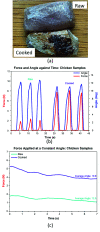Stiffness Assessment and Lump Detection in Minimally Invasive Surgery Using In-House Developed Smart Laparoscopic Forceps
- PMID: 35774413
- PMCID: PMC9216325
- DOI: 10.1109/JTEHM.2022.3180937
Stiffness Assessment and Lump Detection in Minimally Invasive Surgery Using In-House Developed Smart Laparoscopic Forceps
Abstract
Minimally invasive surgery (MIS) incorporates surgical instruments through small incisions to perform procedures. Despite the potential advantages of MIS, the lack of tactile sensation and haptic feedback due to the indirect contact between the surgeon's hands and the tissues restricts sensing the strength of applied forces or obtaining information about the biomechanical properties of tissues under operation. Accordingly, there is a crucial need for intelligent systems to provide an artificial tactile sensation to MIS surgeons and trainees. This study evaluates the potential of our proposed real-time grasping forces and deformation angles feedback to assist surgeons in detecting tissues' stiffness. A prototype was developed using a standard laparoscopic grasper integrated with a force-sensitive resistor on one grasping jaw and a tunneling magneto-resistor on the handle's joint to measure the grasping force and the jaws' opening angle, respectively. The sensors' data are analyzed using a microcontroller, and the output is displayed on a small screen and saved to a log file. This integrated system was evaluated by running multiple grasp-release tests using both elastomeric and biological tissue samples, in which the average force-to-angle-change ratio precisely resembled the stiffness of grasped samples. Another feature is the detection of hidden lumps by palpation, looking for sudden variations in the measured stiffness. In experiments, the real-time grasping feedback helped enhance the surgeons' sorting accuracy of testing models based on their stiffness. The developed tool demonstrated a great potential for low-cost tactile sensing in MIS procedures, with room for future improvements. Significance: The proposed method can contribute to MIS by assessing stiffness, detecting hidden lumps, preventing excessive forces during operation, and reducing the learning curve for trainees.
Keywords: Minimally invasive surgery; angle sensor; force sensor; laparoscopy; lump detection; robotic surgery; stiffness assessment; tactile sensing.
Figures






References
-
- Jiahai C., You L., Jianping G., and Yakun W., “Application of da Vinci surgical robotic system in hepatobiliary surgery,” Int. J. Surgery Med., vol. 4, pp. 22–27, Jan. 2017, doi: 10.5455/ijsm.da-Vinci-surgical-robotic-system-in-hepatobiliary-surgery. - DOI

